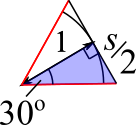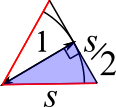Hexagon perimeter
A circle of radius 1 is inscribed in a regular hexagon. What is the perimeter of the hexagon?
Problem
A circle of radius 1 is inscribed in a regular hexagon, as shown below. What is the perimeter of the hexagon?
Image

This problem is adapted from the World Mathematics Championships
Student Solutions
Drawing lines from the centre to each vertex of the hexagon, as shown, splits it into 6 identical isosceles triangles.

The total angle at the centre is $360^\text o$, so the angle at the centre of each triangle must be $360\div6 = 60^\text o$.
Using trigonometry
Since the angle at the middle of each triangle is $60^\text o$, when the triangle is split in half by the radius, as shown below, the angle will be $30^\text o$. In the diagram, $s$ denotes the side lengthof the hexagon.

$\tan {30^\text o}=\dfrac{\frac{s}{2}}{1}\rightarrow\tan{30^\text o}=\frac{s}{2}\rightarrow2\tan{30^\text o}=s$.
$\tan{30^\text o}=\dfrac{1}{\sqrt3}$, so $s=2\times\dfrac{1}{\sqrt3}=\dfrac{2}{\sqrt{3}}$ or $1.155$.
The hexagon has $6$ sides, so its perimeter is $6\times\dfrac{2}{\sqrt3}=2\times\sqrt3\times\sqrt3\times\dfrac{2}{\sqrt3}=4\sqrt3$, or $6\times1.155=6.93$.
Using Pythagoras' Theorem
Since the angle at the middle of each triangle is $60^\text o$, the triangles must be equilateral triangles (as they are already isosceles, so the other two angles are equal, and add up to $120^\text o$).
The diagram below shows one of the triangles cut in half by the radius, where the side length of the hexagon is labelled $s$.

Applying Pythagoras' theorem, $$\begin{align}&1^2+\left(\frac{s}{2}\right)^2=s^2\\
&\Rightarrow1+\dfrac{s^2}{4}=s^2\\
&\Rightarrow4+s^2=4s^2\\
&\Rightarrow4=3s^2\\
&\Rightarrow s^2=\frac{4}{3}\\
&\begin{split}\Rightarrow s&=\sqrt{\frac{4}{3}}\\
&=\dfrac{2}{\sqrt3}\approx1.155\end{split}\end{align}$$
The hexagon has $6$ sides, so its perimeter is $6\times\dfrac{2}{\sqrt3}=2\times\sqrt3\times\sqrt3\times\dfrac{2}{\sqrt3}=4\sqrt3$, or $6\times1.155=6.93$.
Image

The total angle at the centre is $360^\text o$, so the angle at the centre of each triangle must be $360\div6 = 60^\text o$.
Using trigonometry
Since the angle at the middle of each triangle is $60^\text o$, when the triangle is split in half by the radius, as shown below, the angle will be $30^\text o$. In the diagram, $s$ denotes the side lengthof the hexagon.
Image

$\tan {30^\text o}=\dfrac{\frac{s}{2}}{1}\rightarrow\tan{30^\text o}=\frac{s}{2}\rightarrow2\tan{30^\text o}=s$.
$\tan{30^\text o}=\dfrac{1}{\sqrt3}$, so $s=2\times\dfrac{1}{\sqrt3}=\dfrac{2}{\sqrt{3}}$ or $1.155$.
The hexagon has $6$ sides, so its perimeter is $6\times\dfrac{2}{\sqrt3}=2\times\sqrt3\times\sqrt3\times\dfrac{2}{\sqrt3}=4\sqrt3$, or $6\times1.155=6.93$.
Using Pythagoras' Theorem
Since the angle at the middle of each triangle is $60^\text o$, the triangles must be equilateral triangles (as they are already isosceles, so the other two angles are equal, and add up to $120^\text o$).
The diagram below shows one of the triangles cut in half by the radius, where the side length of the hexagon is labelled $s$.
Image

Applying Pythagoras' theorem, $$\begin{align}&1^2+\left(\frac{s}{2}\right)^2=s^2\\
&\Rightarrow1+\dfrac{s^2}{4}=s^2\\
&\Rightarrow4+s^2=4s^2\\
&\Rightarrow4=3s^2\\
&\Rightarrow s^2=\frac{4}{3}\\
&\begin{split}\Rightarrow s&=\sqrt{\frac{4}{3}}\\
&=\dfrac{2}{\sqrt3}\approx1.155\end{split}\end{align}$$
The hexagon has $6$ sides, so its perimeter is $6\times\dfrac{2}{\sqrt3}=2\times\sqrt3\times\sqrt3\times\dfrac{2}{\sqrt3}=4\sqrt3$, or $6\times1.155=6.93$.
